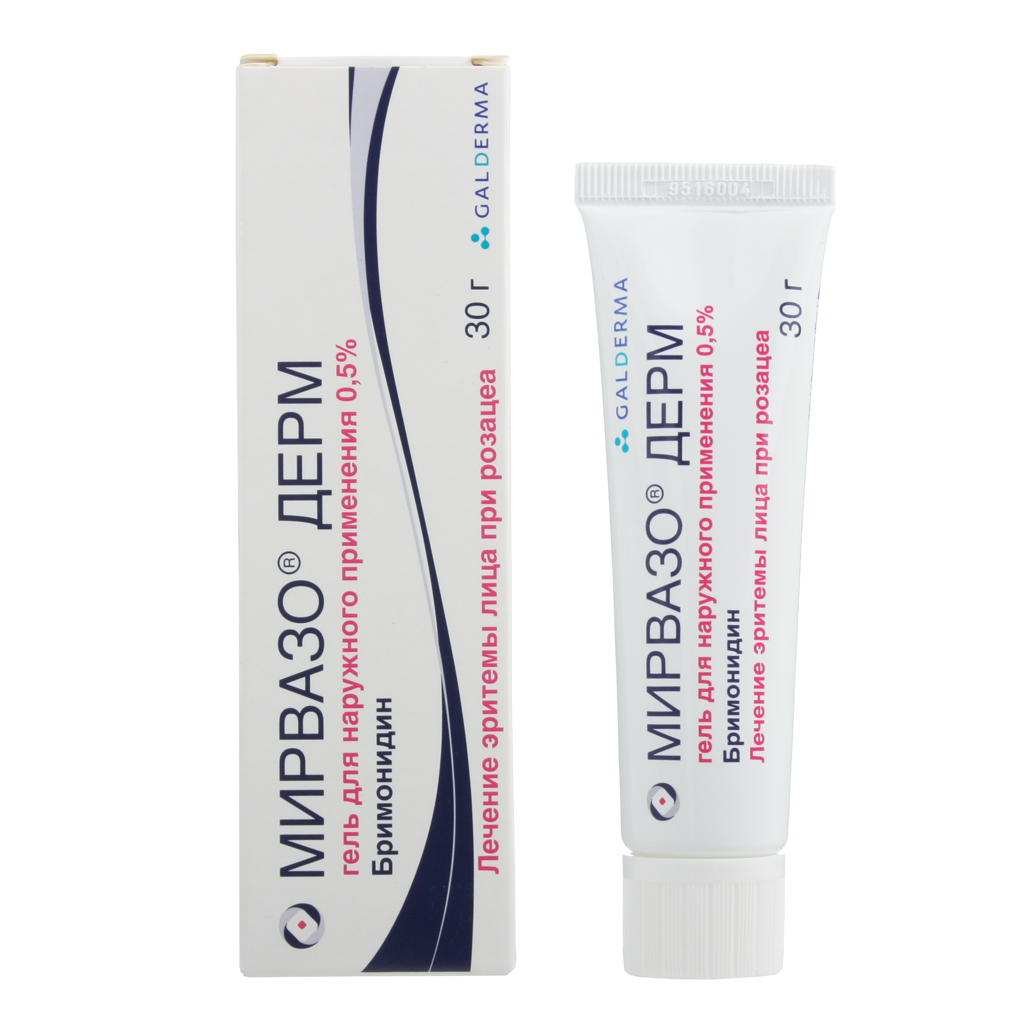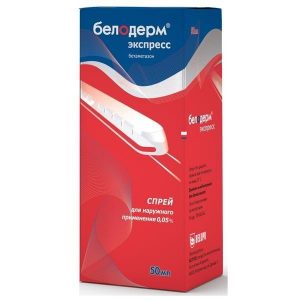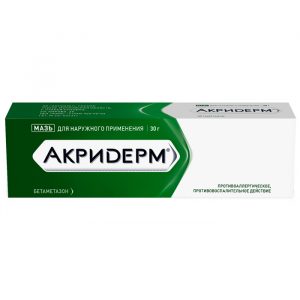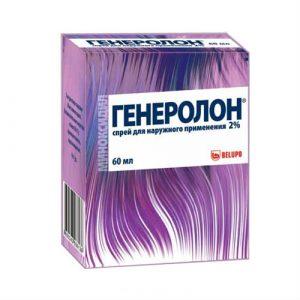Description
Description
Opaque gel from white to light yellow.
Pharmacological action of
Facial erythema with rosacea, a selective treatment alpha-2-adrenergic agonist.
Brimonidine is a highly selective alpha2-adrenergic receptor agonist: its affinity for alpha2-adrenergic receptors is 1000 times that of alpha1-adrenergic receptors.
Application of a highly selective alpha2-adrenergic receptor agonist to the skin leads to a decrease in erythema due to direct vasoconstriction of the skin vessels.
Indications
Treatment of erythema of the face with rosacea.
Contraindications
– Hypersensitivity to brimonidine or to any of the excipients
– children under 18 years of age (safety and efficacy of the drug for this age category have not been established)
– simultaneous administration with monoamine oxidase inhibitors (MAO) (for example, selegiline or mabloid ), and tricyclic (imipramine) and tetracyclic (maprotiline, mianserin and mirtazapine) antidepressants, which affect noradrenergic transmission.
Precautions:
– Pregnancy
– impaired liver and kidney function.
Directions for use
For external use only. A small amount of gel is applied in a thin layer to the skin of each of the 5 areas of the face (forehead, chin, nose, cheeks) once a day in the presence of erythema.
The maximum recommended daily dose of the drug, divided into 5 parts according to the application areas, is 1 g.
When applied to the skin, Mirvazo ® Derm gel should be distributed evenly with a thin layer on the face, avoiding contact with the eyes, eyelids, lips, mouth and the mucous membrane of the nose. The gel should be applied only to the face.
Special instructions
The drug Mirvazo ® Derm should not be applied to irritated skin or open wounds, to the area around the eyes. In case of severe irritation or allergies, it is necessary to interrupt treatment with the drug.
After applying the drug, be sure to wash your hands. The drug Mirvazo ® Derm can be used in conjunction with other drugs used to treat the inflammatory elements of rosacea. They can be applied to the skin only after the Mirvazo ® Derm preparation has dried, and not simultaneously with it. After application and drying of the drug Mirvazo ® Derm, the use of cosmetics is possible. Erythema and hyperemia The effect of the drug Mirvazo ® Derm begins to weaken a few hours after application.
In some patients, the resumption of erythema and transient hyperemia in a more severe form was described than was observed before treatment. Most cases of erythema were noted during the first 2 weeks after starting treatment. In some patients, transient hyperemia was observed. The onset of hyperemia after application of the gel ranged from 30 minutes to several hours.
In most cases, erythema and hyperemia disappeared after discontinuation of the drug. If erythema worsens, the use of the drug should be discontinued. Symptomatic measures, such as cooling, taking non-steroidal anti-inflammatory drugs, and antihistamines, can relieve symptoms. After resuming the use of the drug Mirvazo ® Derm, relapses of exacerbations of erythema and hyperemia were noted.
However, if necessary, treatment can be resumed after restoration of the function of the skin barrier, starting with a trial application of the drug on a small area of the face at least 1 day before the full resumption of treatment of the entire skin of the face. The recommended dose and frequency of application should be strictly observed: once a day, in a very thin layer.
Avoid increasing the maximum daily dose and / or frequency of use, since the safety of increased daily doses or repeated daily use has not been established. The simultaneous use of alpha-adrenergic receptor agonists with systemic agonists can enhance the side effects of this class of drugs in patients with: – severe or uncontrolled, or unstable cardiovascular diseases – depression, insufficiency of cerebral or coronary circulation, Raynaud’s disease, orthostatic hypotension, thromboangiitis obliterans, scleroderma, or Sjogren’s syndrome.
The composition of Mirvazo ® Derm includes methyl parahydroxybenzoate, which can cause allergic reactions (possibly of a delayed type), as well as propylene glycol, which can lead to skin irritation. Influence on the ability to drive transp. Wed and fur .: The drug does not affect or slightly affects the ability to drive vehicles or engage in other potentially dangerous activities that require an increased concentration of attention and speed of psychomotor reactions.
Composition of
1 g of gel contains:
Active ingredient:
Brimonidine tartrate – 5.0 mg.
Excipients:
carbomer – 12.5 mg,
methyl parahydroxybenzoate – 1.0 mg,
phenoxyethanol – 4.0 mg,
glycerol – 55.0 mg,
titanium dioxide – 0.625 mg,
propylene glycol – 55.0 ,
sodium hydroxide – up to pH 6.0,
purified water – up to 1000 mg.
Side effects of
In clinical trials, the most frequent (1.2-3.3%) adverse reactions were observed, including redness, itching, hot flashes and a burning sensation of the skin. As a rule, these were mild or moderate reactions that did not lead to discontinuation of treatment.
Cases of exacerbation of rosacea symptoms have been reported in patients treated with Mirvazo® Derm. Given the data of all clinical trials conducted, cases of exacerbation of symptoms were noted in 16% of patients. Significant differences in the safety profile in elderly patients and patients aged 18 to 65 years were not detected.
In the post-registration period, frequent cases of increased redness, flushing, burning sensation of the skin and blanching of the skin at the site of application were noted.
Adverse reactions from clinical trials (see table 1) are classified by organ systems and developmental frequency. Definition of categories of frequency of adverse reactions: very often (> 1/10), often (> 1/100 to <1/10), infrequently (> 1/1000 to <1/100), rarely (> 1/10 000 to < 1/1000), very rarely (<1/10 000), the frequency is unknown (it is impossible to estimate based on the available data). Drug Interactions No studies have been conducted on drug interactions with other drugs. Brimonidine is contraindicated in patients taking monoamine oxidase inhibitors (MAOs) and patients taking tricyclic and tetracyclic antidepressants, affecting noradrenergic transmission It is necessary to take into account the possibility of additional or potentiating action when combined with brimonidine with substances that inhibit the central nervous system (alcohol, barbiturates, opiates, sedatives or anesthetics). No data are available on the effect of brimonidine on circulating catecholamines. Nevertheless, caution is advised in patients receiving drugs that are able to affect the metabolism of amines and increase their concentration in the blood, such as chlorpromazine, methylphenidate, reserpine. It is recommended to be careful while using brimonidine or changing its dose in the treatment of ophthalmic diseases. Caution is advised when initiating treatment or when changing the dose of co-administered systemic drugs (regardless of their dosage form), which may interact with alpha-adrenergic receptor agonists or affect their activity, i.e. are agonists or adrenergic receptor antagonists (e.g. , isoprenaline, prazosin). In some patients, brimonidine can cause a clinically insignificant decrease in blood pressure, so caution should be exercised when using drugs such as antihypertensive drugs and / or cardiac glycosides simultaneously with brimonidine. Overdose Information on overdose of brimonidine for external use in adult patients is not available. In case of accidental use of the drug, oral overdose effects of alpha2 receptor agonists are possible, such as hypotension, weakness, vomiting, drowsiness, lethargy, bradycardia, arrhythmia, myosis, apnea, hypotension, hypothermia, respiratory depression and convulsions. In a clinical study, 2 cases of serious adverse events caused by accidental ingestion of Mirvazo ® Derm by young children were noted. The symptoms observed in children corresponded to the known symptoms of an overdose of alpha2 receptor agonists in young children and completely disappeared within 24 hours. Treatment of overdose when taking the drug inside includes supportive and symptomatic therapy, it is necessary to maintain airway patency. Storage conditions At a temperature not exceeding 30 ° C. Do not freeze. Keep out of the reach of children. Expiration 2 years. After the first autopsy, store the drug for no more than 6 months, at a temperature not exceeding 25 ° C. Do not use after the expiry date. Pharmacy terms Prescription Form of Treatment claim the gel dlya naruzhnogo primeneniya




